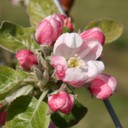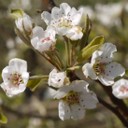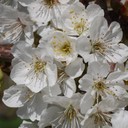Contents
-
Current degree day (DD) accumulations
- Current bud stages
- Orchard Radar synopsis
-
Upcoming meetings
The way I see it
- 2010 New England Tree Fruit Management Guide Available
- In-row weed control timing is now
- Pest watch
- Guest article: Apple Scab Control 2010
- Useful links
Current (through April 19) degree day
(DD) Accumulations
Location: UMass Cold Spring Orchard (CSO), Belchertown, MA
Base 43: 276
Base 50: 133
Significant upcoming orchard events based on degree days (Base 43):
Redbanded leafroller first flight peak: 231-367
Spotted tentiform leafminer 1st flight peak: 263-387
Oriental fruit moth 1st catch: 221-325
European red mite egg hatch: 231-337
Lesser appleworm 1st catch: 260-538
Obliquebanded leafroller larvae active: 158-314
Pear psylla 1st egghatch: 174-328
McIntosh at bloom: 349-419
Current bud stages
| Location | Liberty apple -- 1st bloom | Gold Bosc pear -- early bloom | PF-14 Jersey peach -- bloom | Burgundy (Pearl) cherry -- bloom |
| Belchertown UMass CSO (04/19/10) |
 |
 |
 |
 |
Orchard Radar synopsis
As mentioned in last week's HF, we will be publishing a synopsis of Glen Koehler's (U. of Maine) Orchard Radar pest predictions for Belchertown, MA (UMass Cold Spring Orchard). Orchard Radar uses SkyBit data as input for apple pest occurrence and development models. Only select short-term output of particular interest will be reported here. For the complete set of models see the link above. If you are interested in getting Orchard Radar for you location, you may want to contact Glen Koehler, glen.koehler1@maine.edu.
- 1st Lesser Apple Worm (LAW) flight begins around: April 29, Thursday. Peak trap catch: May 14
- 1st generation OFM flight starts: April 15, Thursday.1 st generation - 55% egg hatch and first treatment date, if needed: May 26, Wednesday
- 1st RBLR flight began around April 5, Monday. Peak trap catch and approximate start of egg hatch: April 19, Monday.
- 1st STLM flight, peak trap catch: April 27, Tuesday. 1st generation sapfeeding mines start showing: May 13, Thursday. Optimum sample date is around Saturday, May 15, when a larger portion of the mines are visible.
- Estimated hatch date of overwintered European red mite (ERM) eggs indicating declining efficacy of prebloom oil treatment is Wednesday, April 14
- Increased risk of Plum Curculio (PC) damage as McIntosh and similar cultivars increase fruit size: May 14, Friday
- Saturday, Apr 24 McIntosh king bloom (Thursday, Apr 29 full bloom)
Upcoming meetings
April 20, 21, 22 2010: Tree fruit twilight meetings
Tuesday, April 20 -- UMass Cold Spring Orchard, 391 Sabin St., Belchertown, MA
(413) 323-6647Wednesday, April 21 -- Macks Apples of Moose Hill Orchards, 230 Mammoth Rd., Londonderrry, NH (603) 434-7619 (joint meeting with New Hamsphire Fruit Growers' Association and UNH Extension; note meeting starts at 5 PM) More information
Thursday, April 22 -- Ledge Ends Produce at the historic Briggs Boesch Farm, 830 South Rd., East Greenwich, RI (401) 884-5118 (joint meeting with Rhode Island Fruit Growers' Association)
Tree fruit twilight meetings start promptly at 5:30 PM. (EXCEPT April 21 meeting in New Hampshire which STARTS at 5 PM.) Pesticide recertification credit will be offered but you must be there at start of meeting to receive credit. There will be a $25 meeting admission charged at the door for the Massachusetts and Rhode Island meetings. ($20 for Massachusetts Fruit Growers' Association FULL members and Rhode Island Fruit Growers's Association members.) For more information, call Jon Clements: 413-478-7219.
Wednesday, April 21 -- Special Tree Fruit Growers' Demonstration: Using a Sprayer Patternator for Calibrating and Orchard Sprayer. 1 to 4 PM. Macks Apples of Moose Hill Orchards, 230 Mammoth Rd., Londonderrry, NH (603) 434-7619. More information.
The way I see it
Going into bloom is a relatively quiet period. Kind of like the calm before the storm. Still the forecast looks favorable for NO frost or freeze in the foreseeable future. (I heard on the news this morning that the volcano in Iceland is going to make longer-term forecasts unreliable because of the lack of data that is a result of the diminished flights across the North Atlantic. Interesting.) A remider that a low temperature of 28 F. will result in 10% kill of fruit buds and 25 F. would kill app. 90%. There has been some brown tinging of cherry flower petals when the temp. dropped to about 30 F. last week, but no bud damage.
We hope to see you at one of the three tree fruit twilight meetings this week.
2010 New England Tree Fruit Management Guide available
As a reminder, the 2010 New England Tree Fruit Management Guide is available for purchase here:
http://www.umass.edu/fruitadvisor/2010/2010netfmg.html
In-row weed control timing is now
The bloom period is a relatively quiet time so it may be a good time to assess your in-row weed control situation and apply an herbicide (or two or three or four). Our standard (and economical) recommendation* (for bearing orchards) where no herbicide was applied in the fall is to use the following tank mix:
- Prowl H2O (3 qt/acre)
- Matrix 25 DF (4 oz/acre)
- Karmex 80 DF (2.5 lb/acre)
- Gramoxone Inteon 2L(3-4 pt/acre, + non-ionic surfactant, NIS)
Now, that should control a broad range of annual grasses and broadleaf weeds as well as provide some burn-down of existing vegetation. Substitions might be Chateau for the Matrix and Karmex, and Rouundup or Rely for the Gramoxone.This tank-mix should be applied as soon as possible in enough water (35-40 gpa) to give good coverage of the weeds and soil surface.
*thanks to Brad Majek, Rutgers University
Pest watch
- make sure apple orchards are covered up with fungicide before the next significant wetting event is predicted (later this week) for apple scab; fungicides of choice (by themself or in-combination) at this time of the year include: Captan, mancozeb fungicides (Penncozeb, Dithane, Manzate, Polyram), Scala, Sovran, Vangard, or Inspire Super MP.
- fire blight becomes a major concern during apple bloom and if temperature/moisture conditions are realized; the best defense against fire blight is to have applied a copper spray at green tip, AND, if environmental conditions are met, a streptomycin spray during bloom; the best way to monitor potential fire blight activity during bloom is to use the models on the MA NEWA web site:
- stone fruit bloom is susceptible to brown rot until shuck split under wet conditions; bloom is the time to get it under control otherwise you will likely struggle with brown rot as fruit matures; fungicides should be applied during bloom if it rains; excellent fungicide choices include: Indar, Rally, Orbit, Elite, Captan (good only), Pristine (good only), and Adament.
- bacterial spot of peach and nectarine becomes active after petal fall; spraying at weekly intervals through the cover sprays with oxytetracycline formulations (Mycoshield or generic) is necessary during periods of wet weather
- pheromone traps set out for Oriental fruit moth (OFM) are useful for determining prevalence, however, most OFM will be controlled with petal-fall sprays; but you can also deploy mating disruption at this time if you choose.
- spotted tentiform leafminer (STLM) are flying and laying eggs, but this generation is typically not treated
- you should be scouting for signs of rosy apple aphid (RAA) infestation; if found, pre-bloom insecticide options include Thiodan 3EC, Actara 25WG, Assail 30SG, Calypso 480SC, and Beleaf 50SG.Now (pre-bloom) is the best time to treat for RAA as they become more difficult to control after bloom.
- you could also be looking for oblique-banded leafroller (OBLR) although the timing for treatment is not optimal (post-bloom is when you need to take action). Presence of the worms now means you will likely have a problem if you don't take action later.
Guest article: Apple Scab Control 2010
George Sundin, Michigan State University, Plant Pathology
Posted April 13, 2010 http://www.ipmnews.msu.edu/fruit/
We are in the thick of apple scab weather right now. As your dedicated state Michigan State University Extension personnel (Mira Danilovich, Amy Irish-Brown, Erin Lizotte, Mark Longstroth, Nikki Rothwell, Phil Schwallier, Bill Shane, Bob Tritten, Diane Brown-Rytlewski) have been telling you, we already have experienced scab infection periods during the first week of April. While orchard spore counts have been relatively low, we need to remember a few things:
We’re in an early season with tree development two to three weeks ahead of normal. It is quite possible that the scab fungus is lagging just slightly this spring in development and spore production. However, last year was a high scab year in most regions. Thus, most orchards would be high-inoculum orchards coming into 2010. Furthermore, since most scab isolates from last year were resistant to strobilurin and sterol inhibitor fungicides, we have only a few fungicide options for 2010.
We must remember that it is much more difficult to effectively control apple scab in a high-inoculum orchard versus a low-inoculum orchard.
Since McIntosh is so highly susceptible to apple scab, controlling scab effectively in a high-inoculum McIntosh orchard will be supremely difficult in 2010. Keep especially vigilant with scab control on all McIntosh blocks.This means that thorough fungicide coverage is absolutely critical throughout the primary scab period through post-bloom into first cover.
I think that we will be seeing plenty of scab spores released with rain events over the next few weeks. With the lack of post-infection tools available, keeping trees covered in advance of rains is critical.
What fungicide choices are still effective in 2010?
EBDCs, Captan – These fungicides are referred to as “contact” or protectant fungicides as they provide a surface barrier on leaves and fruit that kills scab spores and germinating spores. These fungicides include Dithane, Penncozeb, Manzate, Polyram and Captan. These scab protectants typically provide five to six days of protectant activity when used at full rates.
Combinations of Mancozeb fungicides (Dithane, Penncozeb, Manzate) with Captan are especially effective because they combine the excellent retention properties of Mancozeb with the better redistribution properties of Captan. Remember that Captan is not compatible with oil. Redistribution is critical when we experience periods of warmer weather leading to rapid leaf expansion between spray applications.
Anilinopyrimidines – include Vangard and Scala. These are effective scab materials, but at risk for resistance development. At a minimum, should be tank-mixed with a 3 lbs/acre rate of EBDC for resistance management. This class of fungicide is more effective in colder weather. Highly systemic material that doesn’t redistribute well and is not as effective in controlling scab on fruit. Good choice for early-season scab control. We are rapidly approaching the end of the best window for use of this class of scab fungicides.
Sterol Inhibitors – resistance to sterol inhibitors (SI’s) in the scab fungus is widely distributed in Michigan orchards. This resistance affects the so-called first generation SI’s including Rally, Rubigan and Procure. There are second generation SI’s available including Inspire Super and Indar. The second generation SI’s are more effective against scab than the first generation SI’s, and also can control scab in orchards with known SI resistance. However, I would caution against reliance on these materials, particularly with SI resistance at very high levels in Michigan. At a minimum, either Inspire Super or Indar should be tank-mixed with an EBDC to help control SI-resistant scab strains.
Also remember that Inspire Super is actually a combination of two fungicides (the second generation SI difenoconazole and Vangard). Thus, there are two modes of action in there, but the Vangard component is more effective under cooler conditions. An EBDC should still be tank-mixed with Inspire Super because both components of Inspire Super are at risk of resistance development.
Finally, remember that continued use of second generation SI fungicides is predicted to increase the overall level of SI resistance in orchards.
Sulfur, Ziram – weaker protectants, shorter duration of protectant activity means more applications required.
Increasing problems with fungicide resistance in Michigan are requiring alterations in the management of this disease for 2010 and beyond. I anticipate that management programs will be costly, tiring, and perhaps exasperating. Unfortunately, we need to realize that the scab fungus does not get “tired.” The nature of this fungus is to produce large quantities of spores that can be wind and rain-dispersed to green tissue and fruit of apples. With high inoculum, multiply those numbers many times over. This is why complete and consistent fungicide coverage is essential. Because of the high numbers of spores, there will always be another spore during the primary scab season that can find unprotected tissue. Keep that tissue protected.
Useful links
UMass Fruit Advisor http://www.umass.edu/fruitadvisor/
UMass Cold Spring Orchard Weather Data http://www.umass.edu/fruitadvisor/hrcweather/index.html
Scaffolds Fruit Journal http://www.nysaes.cornell.edu/ent/scafolds/
NEWA Apple Disease Models-MA http://newa.nrcc.cornell.edu/newaModel/apple_disease_ma
NEWA Apple Insect Models-MA http://newa.nrcc.cornell.edu/newaModel/apple_pest_ma
Orchard Radar for Belchertown, MA http://pronewengland.org/AllModels/MAmodel/RADARMA-Belchertown.htm
JMCEXTMAN Blog http://jmcextman.blogspot.com/
Follow me on Twitter http://twitter.com/jmcextman and Facebook http://www.facebook.com/jmcextman
